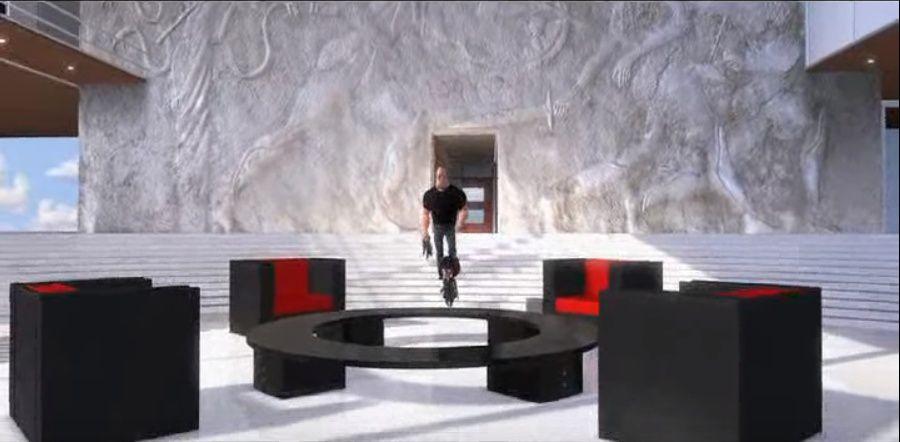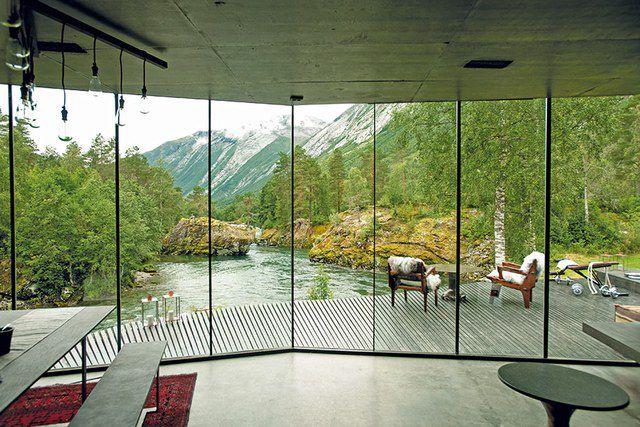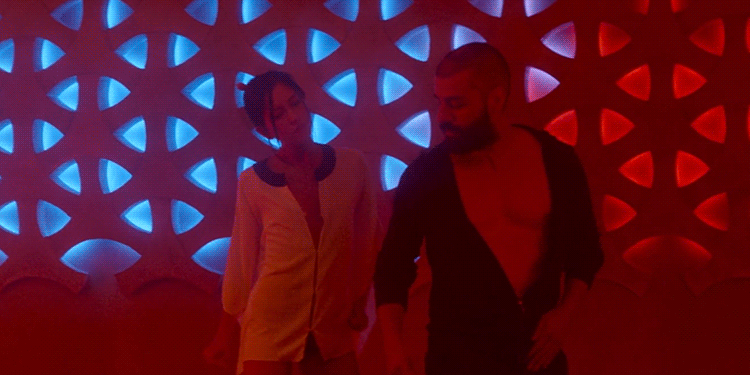
Earlier this week, the Ringer’s movie Slack channel was launched into chaos after Chris Ryan asked staffers which movie house they would choose to live in. Here are the picks and explanations from the most enthusiastic writers and editors:
Edna’s House in The Incredibles
Michael Baumann: The Incredibles is most of all a loving homage to modernist architecture and design, and I couldn’t applaud that sentiment enough. Shutters, dormers, and wraparound porches are for unimaginative people who don’t know they’re unimaginative. I say bulldoze it all and rebuild the world as Mies van der Rohe and Eero Saarinen would. It follows, then, that the film’s reclusive genius designer, Edna Mode, would live in a cathedral to midcentury modernism. Behold her majestic fortress, perched atop a hill like the City of God:

And inside, what scale, what striking use of accent colors! It is at once both minimalist and grand, a rebuke to the stodginess of British manors.

It’s a work of art, as befits the home of a genius aesthete in a movie with a genius-level commitment to aesthetics. Of course, Edna’s house is also outfitted with high-tech security equipment and a secret underground laboratory — complete with Eames chairs on a track. This is, after all, a cartoon about superheroes. “I used to design for gods,” Edna says, but her home is proof that she’s got it backward — it was the gods who designed for her.
The Bond Estate in Skyfall
Justin Charity: I tell anyone who will listen that I want to live in the house from Skyfall. It’s a decrepit, rural estate located deep in Scotland, where no one from Navient or any other loan services agencies will think to find me. The Skyfall estate is mysterious. I could do all sorts of eccentric things and become a historically enigmatic figure or a local bogeyman, at least. I could have artisanal groceries delivered via Javier Bardem’s rockin’ helicopter. I could karaoke into the sky, and my voice would carry for miles and miles.
Miss Honey’s Cottage in Matilda
Claire McNear: The home of Miss Honey — teacher, mentor, and rare non-evil adult in the Roald Dahl universe — is a place of refuge in Matilda, and rightfully so. It’s a cozy cottage, walking distance from the local school, full of potted plants and exposed stonework and floral prints and tasteful knickknacks and many, many teacups. It’s a little small, yes, and a little shabby, but it’s perfectly lovely, with a garden full of flowers that bloom, one imagines, all year long. How could you not feel at home here? Yeah, sure, Matilda also features the stolen Trunchbull mansion, which — spoiler! — Miss Honey returns to at the film’s end. But, eh, too big. Bad memories, and not just of the Trunchbullian variety — the same house also serves as the sorority home in Scream 2, and let’s just say that Sarah Michelle Gellar did not have a good time there. Plus, a lawn? Never had one. Don’t want one. Mowing seems exhausting. I’ll stick to tea and daffodils.
The Beach House in Something’s Gotta Give
Shea Serrano: I’ve never been much for the city. It’s fine, I suppose. And certainly functional. But what I crave more than places to get food at 2 a.m. or competitive schools for my children are: seclusion, easy access to a beach, a gigantic but still somehow understated kitchen, and one billion windows. Which is why if we’re getting to choose a movie house to live in forever, I have to take the house from 2003’s Something’s Gotta Give. There are issues with the movie, sure. (There can be no place or time conceived of where someone would choose to be in a relationship with Jack Nicholson’s Harry Sanborn, a 63-year-old hip-hop mogul, over being in a relationship with Keanu Reeves’s Julian Mercer, a 36-year-old doctor with impeccable hair and no connection to Suge Knight, but Diane Keaton’s Erica Barry ends up choosing Nicholson.) But there are no issues with the house. It’s beautiful. It’s perfect, both in style and in essence. It very well might be the best movie house Nancy Meyers, a savant, has ever dreamed up. Give me that one. I want no other.
Anthony Hopkins’s Mansion in Transformers: The Last Knight
Miles Surrey: I believe that a good house is only as good as one’s company, and for that reason, Sir Anthony Hopkins as Sir Edmund Burton in Transformers: The Last Knight has everyone beat. He lives in a giant mansion in the English countryside, and as long as the water pressure is strong, that’s a big plus (we never see Sir Edmund Burton shower, so, admittedly, this is unclear).
But what elevates this quaint abode to Hall of Fame movie house status is Burton’s companions. He has a robot butler named Cogman, who is apparently from the Transformers’ steampunk era (??) and can transform into an Aston Martin, the best make of British car. Burton also has “Britain’s loneliest dog,” a pit bull that is the goodest of good boys. Name a more iconic duo.
The icing on the cake is what lurks in Burton’s basement: King Arthur’s original round table and the exhaustive history of a society that kept the existence of Transformers a secret for centuries. Imagine lighting a fire with your good boy on your lap, getting served cognac from your robo-butler, and reading about how Harriet Tubman worked alongside Transformers on the Underground Railroad. A better fictional house doesn’t exist.
Meg Ryan’s Brownstone Apartment in You’ve Got Mail
Lindsay Zoladz: You’ve Got Mail wasn’t the first time I saw New York City onscreen when I was a kid, but it was the first time I remember seeing New York City as a home — a place where people worked, chatted, strolled through outdoor markets while arguing with emotionally stunted men about Joni Mitchell, and, when they were home sick from work with their annual spring cold, buzzed into their cozy brownstone apartments kind friends who would surprise them with flowers. You’ve Got Mail is admittedly a rose-colored, wittily romanticized (which is to say, Ephronicized) vision of New York, and yet I think it is also at least 30 percent responsible for why I ended up here — not the first half of the movie, when Meg Ryan has to share the space with her pretentious boyfriend (Greg Kinnear) and the indignant clacking of his typewriter, but the second half, after they’ve broken up and she is suddenly liberated by the fact that she has the space all to herself and can go a little overboard with the floral prints. I’m sentimentally partial to this fictional apartment because it’s the first time I remember seeing a movie in which an adult woman was living alone in New York and loving it. Of course, the You’ve Got Mail apartment is a modest-sized abode (especially compared to my runner-up answer to this question, which is the house from Richie Rich). But, in the immortal words of Jenny Slate, swooning over her post-break-up one-bedroom in an interview last year, “It’s just a little mouse house. It’s fucking perfect for me.”
Stokesay Court in Atonement
Kate Halliwell: Anyone who says they don’t want to live in a movie house that has its own name is objectively incorrect, and Stokesay Court — the mansion from Atonement — makes Downton Abbey look like your shitty postgrad starter apartment. The house plays a pretty important role in the first half of Atonement, as the characters lounge around in its gilded sitting rooms, outside on the grounds, in the lake, or among the gardens. (There’s a lot of lounging in the first 45 minutes of Atonement.) We all know, however, that the most important room in Stokesay Court is the library, and while I probably wouldn’t have any scandalous trysts against the shelves, I’d definitely take that iconic green dress (which would be conveniently hanging in one of the closets) out for a spin. I bet it’s perfect for lounging.
The Martinique House in The Thomas Crown Affair
Amanda Dobbins: What do I look for in a fictional home? Let’s start with the basics: abundant natural light; ample closet space; attractive floorboards; built-in shelving of some kind. The kitchen must be renovated; the garden must be lush. Nancy Meyers is an obvious inspiration for West Coast living, and Nora Ephron has mastered the New York City version. But I have a dream that is bigger than domestic bliss, and it is: elite vacation bliss. So please behold the Martinique house from The Thomas Crown Affair (1999).
The bougainvillea! The direct beach access! The closet full of optional-but-tasteful linen garments! I am also assuming the home comes with a private plane and enough confidence to burn priceless works of art. (Not that I would.) What a life I will lead, on this perfect island home. Please do not try to contact me.
Elio’s Parents’ Italy House in Call Me by Your Name
Hannah Giorgis: Call Me by Your Name is a touching story of love, friendship, and self-discovery. And thanks to director Luca Guadagnino’s sharp eye, it also functions as a dreamy, feature-length advertisement for Villa Albergoni, the rustic 17th-century estate where much of the film takes place. With the help of interior designer Violante Visconti di Modrone, Guadagnino established the Lombardy villa as the perfect setting to capture the film’s warmth: sprawling, lush, and full of nooks that hold countless stories. The house spans several floors, but it never feels so vast as to render it cold; the décor of each room invites socializing, but at the villa’s core is space for art. Many of Elio (Timothée Chalamet) and Oliver’s (Armie Hammer) most tender moments happen on parts of the estate that they carve out for themselves, creating the effect of multiple worlds within the villa. I want nothing more than to cook alongside Mafalda in that massive kitchen, eat outside in the garden, and luxuriate by the multiple natural water sources all day only to come inside after the sun sets and read for hours by the warmth of the fire. Maybe I’d even learn to play piano. The house is that inspiring.
Jodie Foster’s “Townstone” in Panic Room
Alyssa Bereznak: Sure, plenty of movie real estate looks cool. But as a skeptical veteran of the ruthless New York City renter’s market, I have to wonder: How much do we really know about these properties? Like, the Royal Tenenbaums family home is super charming and colorful, but maybe the plumbing is a nightmare! The Long Island mansion in Wolf of Wall Street is perfect for parties, yes, but I bet you anything it has bright white, easily stainable ’80s carpeting. What makes Jodie Foster’s spacious Upper West Side home in Panic Room so attractive is that the film is designed to offer practical details about what you’re getting right off the bat. “It’s 4,200 square feet, has four floors, a courtyard, and south-facing garden in the back,” a friend explains to Jodie Foster’s character, a recent divorcée, at the beginning of the film. When they meet the realtor, he informs her and her daughter that the building is a cross between a brownstone and a townhouse, or, in his words, a “townstone.” I’m not sold on the portmanteau. In fact, I never want to hear it again. But the subsequent tour seals the deal for me: gorgeous, high ceilings, pretty pre-war accents, twisty staircases, and a roomy soaking tub. Yes, there’s also a high-security “panic room” where Jared Leto stupidly hid a bunch of money, but that does not change the fact that this home is a very nice place to live!
The White House (Movie/TV Version Only)
Shaker Samman: When it was first constructed, the White House was a residence with no equal. Later, additions of the West and East wings made the mansion the center of American democracy, but with only sporadic improvements thereafter — shouts to the sub-basement that added a dentist’s office, a medical clinic, and air conditioning — the building itself is less a palace and more a crumbling relic of neoclassical architecture. The hallways are narrow, the offices are cramped, the roof is leaky, and there are infestations of just about every insect and rodent you can imagine. Why on earth would I want to live in a dump like that?
Well, I don’t. I want to live in the Movie/Television White House, where the staircases are grand, the Greek pillars that mark the lobby are perfectly accented by festive lighting, and nobody seems to complain about shoddy craftsmanship or decay. I’ve never seen a film or show, be it My Date With the President’s Daughter or The West Wing, that didn’t make living in the Executive Residence look like a dream. I can get past how it always seems to get blown up in movies, so spending my time there would be a dream.
Tom and Nicole’s Apartment in Eyes Wide Shut
K. Austin Collins: I’m millennial enough not to care about houses, honestly. I grew up in the suburbs and would happily never clean a rain gutter or shovel snow again — genuinely, fuck that. Give me Tom and Nicole’s New York apartment in Eyes Wide Shut because it 1) is big and 2) lacks rain gutters. According to Cruise, the couple’s lush, doctor’s-salary digs were a recreation of Stanley Kubrick and his artist wife Christiane’s own NYC apartment, down to their actual furniture and artwork painted by Christiane herself.
Question, though: Is the weed Tom and Nicole stash in their Band-Aid container another one of those recreated touches from the Kubrick household, and if so, why are you hiding weed in your own home??? But anyway, when the apartment is mine, the stash is mine — thanks. I’ll also take all the furniture (including the gratuitous mirrors and the Christmas lights, which I’ll leave up year-round to really set the mood) and will even settle for a good bargain on the marital discord that’s still probably stinking up the place. Rich people problems are vintage; they give the place character. I like that.
Nathan’s Lair in Ex Machina
Donnie Kwak: Some things I like, in no particular order: trees, minimalist decor, natural light, privacy. So that’s why I’m choosing to live in Nathan’s forest lair from Ex Machina (which is actually a composite of a private residence and a hotel on the west coast of Norway).

I imagine starting every morning by venturing outside to my expansive deck and sitting on one of the vintage Brazilian safari chairs, ensconced in the softest of sheepskin. Beside me: an espresso, a Kindle, a vape pen. I breathe in the calm of the Norwegian forest; I exhale all the stress of the life I had before I moved in here. At night, I boogie.

The House in Mrs. Doubtfire
Kate Knibbs: The Mrs. Doubtfire house is the pinnacle of classy living in film, no matter how hard Nancy Meyers might try to usurp it. It’s big — but not too big, and you’d only need one housekeeper and/or ex-husband in drag for immaculate upkeep. It’s prime San Francisco real estate, a wide corner lot, so the value’s never going down. It’s got historic resonance, as it was built in 1893. Most importantly, it has turrets, and I’ve always wanted to live in a house with turrets.
The Apartment in Big
Daniel Chin: I was going to pick Tony Stark’s Malibu mansion, because, well, it’s phenomenal, but I realized I’d miss my hopeless New York Knicks too much. Plus, I’d surely wind up spending time in L.A. and that traffic just ain’t for me. I’ll stick to the subway and take Josh’s apartment in Big. Great location, solid view, nice high ceilings, and so much room for activities. This was the coolest apartment ever when I first saw this movie as a kid, but I’d probably have to make some adjustments so I don’t rattle my guests like Josh did. I’m gonna swap out the bunk bed for something real, obviously keep the Gumby chair because it’s incredible, and probably get rid of the trampoline — that’s just a bad idea with all those windows. I’ll rearrange the layout, condense the toy collection (you’re out of your damn mind if you think I’m just throwing all of it away), and maybe buy myself a massive flat-screen TV, and I’m living the dream.
The Burrow in Harry Potter
Danny Heifetz: As I began perusing movie homes, I found a dark correlation: The more beautiful the house, the more sad the residents. That’s why I’m choosing the house of the happiest family I know — the Weasley family’s home in Harry Potter, affectionately known as The Burrow.
You can’t beat waterfront property surrounded by rolling hills and meadows, but the Burrow goes beyond aesthetics. It’s perfect for gatherings big and small, whether it’s a family reunion or a secret resistance meeting to plan the overthrow of Wizard-Hitler. Throughout the books and the movies, the Weasleys’ home is a port in a storm. The Burrow may not be the flashiest pick, but it’s charmed with the spell that makes a house into a home: Love.
The Dream House in Miracle on 34th Street
Katie Baker: I was all set to claim (extremely Marky Mark voice) Mistah Walkah’s house from Fear, with its Pacific Northwest seclusion, its scenic pool, and its complicated security system. But then I remembered that even if I didn’t have to worry about a violent orphan stalking my teenaged daughter, I’d still have to live in constant nervous anticipation of The Really Big One causing a tidal wave or a cliffside crumble that would swallow up my home, and I don’t need those problems. So I’m hightailing it to a more traditional and/or boring residence in a location that is a little more impervious to natural disaster: the big yellow dreamhouse from the updated John Hughes version of Miracle on 34th Street, located in Lake Forest, Illinois. Check out those window seats! Those dormer windows! Those backyard GROUNDS! This is a house where children can have an elaborate rec room or several, teens can host some kicking ragers, and adults can pretend to have a headache and nap for hours by the pool. True, my neighbors might be annoying Blackhawks fans, but that’s a small price to pay. Thanks in advance, Santa — I’ve always believed in you.
Greystone Mansion, a.k.a. Daniel Plainview’s House in There Will Be Blood
Jordan Coley: I, like many, have always wanted to be an early 20th century, American oil magnate. I often dream of the house I’d buy filled with all the amenities afforded in the life of a turn-of-the-century industrial monopolist: an ice box that’s always fully stocked, a six-car garage (one for each of my customized Model T’s), an in-home Nickelodeon theater, and even, dare I say it, my very own soda pop fountain. But there’s one home feature in particular that I would be most excited to buy with my Gilded Age, petroleum fortune — a bowling alley.
Can you imagine any better way to blow off steam after a long day of patrolling the oil fields than playing with some pins? Daniel Plainview certainly didn’t seem to think so. His gorgeous two-laner makes its appearance at the end of Paul Thomas Anderson’s 2007 masterpiece There Will Be Blood. The house used for the film is actually Greystone Mansion — a Tudor revival beauty in Beverly Hills built by real-life oil tycoon Edward L. Doheny (the man upon which Daniel’s character is partially based). Sure, Daniel’s malevolent greed and emotional vacancy have probably left him with no real friends to bowl against. And fine, he does in fact use of the one of the pins to bludgeon a man to death in a megalomaniacal fit of rage. But look at that maple finish!

